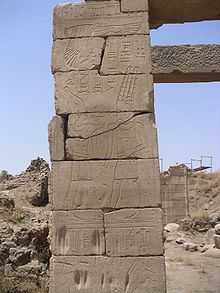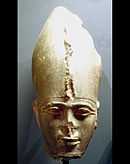Psamtik III
| Psamtik III | ||||||||||||||||||||||||||||||||||||||
|---|---|---|---|---|---|---|---|---|---|---|---|---|---|---|---|---|---|---|---|---|---|---|---|---|---|---|---|---|---|---|---|---|---|---|---|---|---|---|
| Psammetichus III | ||||||||||||||||||||||||||||||||||||||
 Relief depicting Psamtik III from a chapel in Karnak | ||||||||||||||||||||||||||||||||||||||
| Pharaoh of Egypt | ||||||||||||||||||||||||||||||||||||||
| Reign | 526–525 BC, 26th dynasty | |||||||||||||||||||||||||||||||||||||
| Predecessor | Amasis II | |||||||||||||||||||||||||||||||||||||
| Successor | Cambyses II, Second Ruler of Persia | |||||||||||||||||||||||||||||||||||||
| ||||||||||||||||||||||||||||||||||||||
| Children | Amasis | |||||||||||||||||||||||||||||||||||||
| Died | 525 BC | |||||||||||||||||||||||||||||||||||||
Psamtik III (also spelled Psammetichus or Psammeticus) was the last Pharaoh of the Twenty-sixth Dynasty of Egypt from 526 BC to 525 BC. Most of what is known about his reign and life was documented by the Greek historian Herodotus in the 5th century BC. Herodotus states that Psamtik had ruled Egypt for only six months before he was confronted by a Persian invasion of his country led by King Cambyses II of Persia.[1] Psammetichus was subsequently defeated at Pelusium, and fled to Memphis where he was captured. The deposed pharaoh was carried off to Susa in chains, and later executed.
Family
Psamtik III was the son of the pharaoh Amasis II and one of his wives, Queen Tentkheta. He succeeded his father as pharaoh in 526 BC, when Amasis died after a long and prosperous reign of some 44 years. According to Herodotus, he had a son named Amasis and a wife and daughter, both unnamed in historical documents.
Defeat and imprisonment

Psamtik ruled Egypt for no more than six months. A few days after his coronation, rain fell at Thebes, which was a rare event that frightened some Egyptians, who interpreted this as a bad omen. The young and inexperienced pharaoh was no match for the invading Persians. After the Persians under Cambyses had crossed the Sinai desert with the aid of the Arabs, a bitter battle was fought near Pelusium, a city on Egypt's eastern frontier, in the spring of 525 BC.[2] The Egyptians were defeated at Pelusium and Psamtik was betrayed by one of his allies, Phanes of Halicarnas. Consequently, Psamtik and his army were compelled to withdraw to Memphis.[3] The Persians captured the city after a long siege, and captured Psamtik after its fall. Shortly thereafter, Cambyses ordered the public execution of two thousand of the principal citizens, including (it is said) a son of the fallen king.
Captivity and execution
According to book III of The History by Herodotus, Psamtik's daughter was enslaved, his son given a death sentence, and a male companion was turned into a beggar. They were all brought before him to test his reaction, and he only became upset over seeing the state of the beggar. Psamtik III was spared but his son was cut to pieces. The deposed pharaoh was imprisoned and taken to Susa in chains where he was initially treated relatively well. After a while, however, Psamtik reportedly plotted a rebellion against Cambyses and was executed for his involvement in this conspiracy by being forced to drink bull's blood thereby causing his death.


![N5 [ra] ra](/2014-wikipedia_en_all_02_2014/I/media/h/i/e/r/hiero_N5.png)
![S34 [anx] anx](/2014-wikipedia_en_all_02_2014/I/media/h/i/e/r/hiero_S34.png)
![D28 [kA] kA](/2014-wikipedia_en_all_02_2014/I/media/h/i/e/r/hiero_D28.png)
![N35 [n] n](/2014-wikipedia_en_all_02_2014/I/media/h/i/e/r/hiero_N35.png)

![Q3 [p] p](/2014-wikipedia_en_all_02_2014/I/media/h/i/e/r/hiero_Q3.png)
![S29 [s] s](/2014-wikipedia_en_all_02_2014/I/media/h/i/e/r/hiero_S29.png)
![G17 [m] m](/2014-wikipedia_en_all_02_2014/I/media/h/i/e/r/hiero_G17.png)
![V13 [T] T](/2014-wikipedia_en_all_02_2014/I/media/h/i/e/r/hiero_V13.png)
![V31 [k] k](/2014-wikipedia_en_all_02_2014/I/media/h/i/e/r/hiero_V31.png)